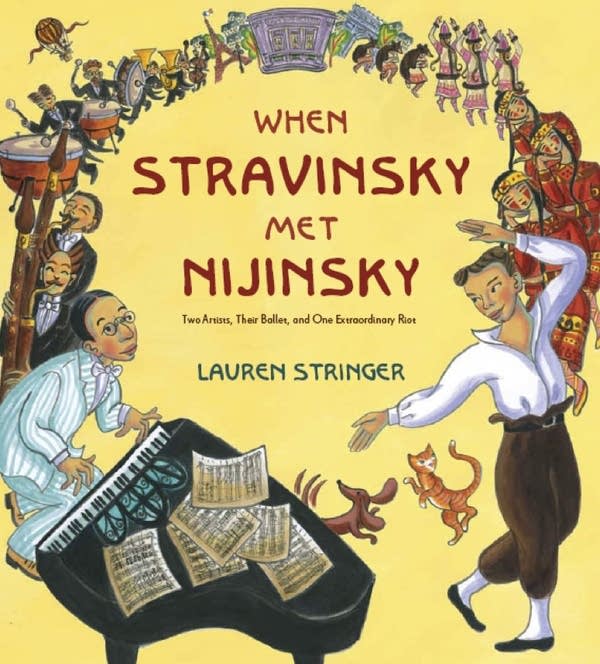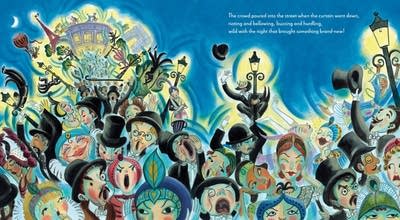'When Stravinsky Met Nijinsky;' how a ballet started a riot
Go Deeper.
Create an account or log in to save stories.
Like this?
Thanks for liking this story! We have added it to a list of your favorite stories.

One hundred years ago today, the world premiere of "The Rite of Spring" in Paris shook the orchestral world and, according to some, launched the modern dance movement. It also sparked a riot in the Parisian streets.
Composer Igor Stravinsky wrote the score in partnership with choreographer Vaslav Nijinsky. Their collaboration is the subject of a children's book by Minnesota author and illustrator Lauren Stringer, called, "When Stravinsky Met Nijinsky: Two Artists, One Ballet, and One Extraordinary Riot."
Stravinsky and Nijinsky were two Russian artists who revolutionized classical music and dance in the 20th century. In the beginning of her book, Stringer describes how they were already major figures before they met.
Turn Up Your Support
MPR News helps you turn down the noise and build shared understanding. Turn up your support for this public resource and keep trusted journalism accessible to all.
"When Stravinsky composed music all by himself,
His piano trilled an orchestra,
with violins and flutes, trumpets and tubas,
and kettledrums that lightly pom di-di-pommed
with the ringling and tingling of cymbals and bells.
But he dreamed of making something different and new."
When Nijinsky composed dances all by himself,
his torso floated - a swan. His legs leaped - a deer!
And his feet, like a sparrow, tippy-tip-toed,
while his arms curved and swerved like a snake.
But he dreamed of making something different and new."
"Making something different and new" is a refrain Stringer repeats throughout the book. It's Stravinsky and Nijinsky's prime motivation.

They came together amid the massive cultural foment of the early 20th century. Cubism had overtaken the art world. Rules were being broken or rewritten in one artistic discipline after another.
Lauren Stringer learned about Nijinsky the dancer before she was exposed to Stravinsky the composer. She was a 16-year-old receptionist at a ballet studio, where she also took lessons. Whenever she had a chance, she would read the dance magazines that were lying around. The consensus in the articles was that Nijinsky was one of the most instrumental dance artists of his time.
"Martha Graham was the first to say that -- that he was the greatest dancer of the 20th century and probably the most innovative choreographer," she said.
Stringer came to understand the power and originality of "The Rite of Spring" through her husband, composer Matthew Smith. Smith discovered Stravinsky and his signature work when he was a boy.
"His first concert, I believe, at the Cleveland Orchestra was 'The Rite of Spring,' and Matthew just could not get enough of it -- and he was very young," Stringer said. "He said it just made him feel alive. And that's when I first thought this piece of music could really, really work for children."

It wasn't until Stringer and Smith went to a Minnesota Orchestra concert in 2005 that the idea of writing a children's book about one of Stravinsky's most experimental and chaotic compositions first took hold.
The orchestra was playing another Stravinsky/Nijinsky ballet called "Petrouchka." On the program there was a picture of the young Stravinsky, looking dapper but stiff in a coat and tails, standing next to Nijinsky, dressed as Petrouchka, the sad puppet.
"It was a gorgeous photo, and they were so young," Stringer recalled. "I was used to older pictures of Stravinsky, but I love seeing the young photos. So I said, 'I wonder what it was like when they met -- when Stravinsky met Nijinsky, they must have been in their 20s.'
"And then I looked at Matthew and said, 'When Stravinsky met Nijinsky.' And we both laughed because ... that's not only a perfect title, but it has all the provocations of a story within it."
"Stravinsky inspired Nijinsky.
Nijinsky inspired Stravinsky.
Together they decided to dream of something different and new.
Stravinsky said, "Nijinksky, let's remember our old home Russia.
Perhaps from the old will come something new?
I'll play a deep forest where dancers can leap.
They'll need night drums that rumble and fires that blaze."
And Nijinsky said, "Yes! they will jump round in circles and their feet must be muddy.
Can you make a mud sound?"
And Stravinsky answered, "As long as it's LOUD!"
The fact that the music has "so much rhythm, it's so loud, it changes so much," is why Stringer believed the music would be appealing to children.
"It has dissonance and then it has melody; folk melodies stream in and out of it," Stringer added. "The beating rhythms of the drums -- I think that kids can quickly get excited about. It is so loud that I think it just fills their little bodies with excitement!"
The night began sweetly with a single bassoon.
Then it grew louder, Louder, LOUDER!
The dancers stomped and skipped and jumped--
"They're not dancing the way dancers should dance!"
The orchestra pounded and squeaked and blared--
"They're not making music the way orchestras should!"
It's hard to imagine any work of art in America provoking civil unrest. But that's what happened in Paris on May 29, 1913, when Stravinsky's "The Rite of Spring," about his favorite season in his old mother Russia, premiered.
Some people hated it! They were nettled by the new.
They stood on their seats and shouted "Boo! Boo! Boo!"
And some people loved it! They were excited by the new.
They stood on their seats and shouted, "Bravo! Bravo! Bravo!"
The music sounded so different, and Nijinsky's movements looked so wild and primal, people were either enthralled or repulsed, and they ended up fighting in the streets.
It's a somewhat violent expression of another point Stringer wanted to make in her book, about the importance and validity of having your own opinion about art.
"It wasn't until I actually wrote it in the story -- that some people hated it, and they threw hats and hairpins and gloves and boots, and they stood on their seats and pounded their fists," she said. "And then when some people love it, they do the exact same thing."
"I think what I loved in writing the story for children was ... it was about two artists who wanted to do something different and new, and I think that's something that all kids want to do: 'Don't copy me, I'm doing something different and new,' " Stringer said. "It conveys the idea that collaboration can work, you don't have to be alone as an artist. And that you can do something so different and so new that some people will love it and some people will hate it."
There was one line Stringer wrote early on, which didn't make it into the book, that sums up Stravinsky and Nijinsky's artistic union perfectly.
"When two people meet, their worlds are changed, and sometimes when two people meet, they change the world."




